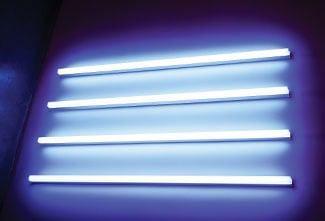Oftentimes, our service department is asked about replacing standard incandescent or fluorescent lighting with newer LED technology in homes and offices. There are a few things to consider before you make the plunge, but they might not be what you think.
Cost and rate of return
It is widely known that LED bulbs cost more than their incandescent and CFL cousins on the front end. To get a return on investment, you really need to do some math. Using average costs of electricity and an average number of hours a bulb will be in use, LED bulbs will save just pennies over CFLs and perhaps around $40 annually over incandescent bulbs, depending on the bulbs.
With such a low rate of return, why bother? Remember, LED bulbs last longer at an average lifespan of 25,000 hours as compared to 8,000 (CFLs) and 1,200 (incandescents). Depending on how conveniently located the bulbs are or how many you might have to replace over time, LED lighting might start looking more and more attractive.
Right light for the task - no waiting
Convenience aside, LEDs aren't for every use. LEDs give a very direct form of light. They're great for down lighting or task lighting. Given their longevity, LEDs make good choices for general lighting that is used most often but be advised: LEDs may require different dimmer switches or mounts. Do your homework before taking the plunge.
Because they are more efficient, LEDs don't generate the heat that incandescent bulbs and halogens do and they don't need the warm-up time of CFLs. So they are a quick and sure form of lighting.
What color temperature is best?
Probably the one feature that will make a difference in your decision-making is also one of the more interesting features of LED lighting: the available color temperatures. What is color temperature of a light bulb? LED Bulbs range in color temperature from bright cool blue tones to warm tones that rival incandescent bulbs. And, they perform quite well in this category comparison.
The color temperature of a light is measured in degrees Kelvin. Incandescent and Halogen lights have a temperature of 2700K, putting out a warm white color. Fluorescent and LEDs come in everything from the same warm white to daylight (6500K). If you're looking for easy-to-live with tones, stick with the lower color temperatures (2500-3000K) that match incandescent bulbs. If you need bright office lighting, the 3500K to 4000K lights are the most common for both brightness and glare reduction. A workshop, warehouse, or plant floor would be better served with the 5000K-6500K range that replicates daylight.
How does the light affect how humans see?
How well a light renders color is another factor that you need to consider. Measured along the Color Rendering Index (CRI), light quality is graded on a scale from 0-100 relative to a standardized sample. The CRI rating is independent of the color temperature of a light source. The CRI indicates how a light source will make colors appear to the human eye. So, you'll want to be sure to know the CRI rating of your lighting if you're lighting an art studio, retail clothing store or paint store, for example.The most common CRI level chosen is 80CRI. When a higher color definition is needed, try 90CRI.
Lighting that lives lightly on the planet
For the environmentally conscious, LEDs lack the hazardous mercury of the CFL. Coupled with longevity, LED options start to appear particularly attractive. Plus, LEDs don't burn out like Halogen, incandescent, or CFLs. They will simply go dim with depreciating lumen output over time, further lengthening their lifespan.Typically at their rated lifespan, they still give off 70-80% of their original lumen level.
Focus on Energy Credits
In many cases, replacing fixtures, lamps, and bulbs will qualify for Focus on Energy incentives, which help reduce your final cost. Small businesses with a kilowatt usage of 40,000 or less in the months of July and August for 2 years, qualify for even higher incentives in 2017.
LED vs Incandescent vs CFL
LED, incandescent, CFL: which is best for your home or work space? That really depends on your location, lifestyle, tasks and budget.
